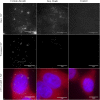Comparison of Confocal and Super-Resolution Reflectance Imaging of Metal Oxide Nanoparticles
- PMID: 27695038
- PMCID: PMC5047631
- DOI: 10.1371/journal.pone.0159980
Comparison of Confocal and Super-Resolution Reflectance Imaging of Metal Oxide Nanoparticles
Abstract
The potential for human exposure to manufactured nanoparticles (NPs) has increased in recent years, in part through the incorporation of engineered particles into a wide range of commercial goods and medical applications. NP are ideal candidates for use as therapeutic and diagnostic tools within biomedicine, however concern exists regarding their efficacy and safety. Thus, developing techniques for the investigation of NP uptake into cells is critically important. Current intracellular NP investigations rely on the use of either Transmission Electron Microscopy (TEM), which provides ultrahigh resolution, but involves cumbersome sample preparation rendering the technique incompatible with live cell imaging, or fluorescent labelling, which suffers from photobleaching, poor bioconjugation and, often, alteration of NP surface properties. Reflected light imaging provides an alternative non-destructive label free technique well suited, but not limited to, the visualisation of NP uptake within model systems, such as cells. Confocal reflectance microscopy provides optical sectioning and live imaging capabilities, with little sample preparation. However confocal microscopy is diffraction limited, thus the X-Y resolution is restricted to ~250 nm, substantially larger than the <100 nm size of NPs. Techniques such as super-resolution light microscopy overcome this fundamental limitation, providing increased X-Y resolution. The use of Reflectance SIM (R-SIM) for NP imaging has previously only been demonstrated on custom built microscopes, restricting the widespread use and limiting NP investigations. This paper demonstrates the use of a commercial SIM microscope for the acquisition of super-resolution reflectance data with X-Y resolution of 115 nm, a greater than two-fold increase compared to that attainable with RCM. This increase in resolution is advantageous for visualising small closely spaced structures, such as NP clusters, previously unresolvable by RCM. This is advantageous when investigating the subcellular trafficking of NP within fluorescently labelled cellular compartments. NP signal can be observed using RCM, R-SIM and TEM and a direct comparison is presented. Each of these techniques has its own benefits and limitations; RCM and R-SIM provide novel complementary information while the combination of modalities provides a unique opportunity to gain additional information regarding NP uptake. The use of multiple imaging methods therefore greatly enhances the range of NPs that can be studied under label-free conditions.
Conflict of interest statement
LC is an employee of Nikon Instruments. Although Nikon had no role in the funding or oversight of the studies presented, this could be indicative of an indirect COI. This does not alter our adherence to PLOS ONE policies on sharing data and materials.
Figures







References
-
- Handy RD, Owen R, Valsami-Jones E. The ecotoxicology of nanoparticles and nanomaterials: current status, knowledge gaps, challenges, and future needs. Ecotoxicology [Internet]. 2008. July [cited 2016 May 4];17(5):315–25. Available from: http://www.ncbi.nlm.nih.gov/pubmed/18408994 10.1007/s10646-008-0206-0 - DOI - PubMed
-
- Zhang J, Nazarenko Y, Zhang L, Calderon L, Lee K-B, Garfunkel E, et al. Impacts of a nanosized ceria additive on diesel engine emissions of particulate and gaseous pollutants. Environ Sci Technol [Internet]. 2013. November 19 [cited 2016 Mar 28];47(22):13077–85. Available from: http://www.pubmedcentral.nih.gov/articlerender.fcgi?artid=4066369&tool=p... 10.1021/es402140u - DOI - PMC - PubMed
-
- Smijs TG, Pavel S. Titanium dioxide and zinc oxide nanoparticles in sunscreens: focus on their safety and effectiveness. Nanotechnol Sci Appl [Internet]. 2011. January [cited 2016 May 4];4:95–112. Available from: http://www.pubmedcentral.nih.gov/articlerender.fcgi?artid=3781714&tool=p... 10.2147/NSA.S19419 - DOI - PMC - PubMed
-
- Forster SP, Olveira S, Seeger S. Nanotechnology in the market: promises and realities. Int J Nanotechnol [Internet]. Inderscience Publishers; 2011. May 20 [cited 2016 May 4]; Available from: http://www.inderscienceonline.com/doi/abs/10.1504/IJNT.2011.040193 - DOI
-
- Aitken RJ, Chaudhry MQ, Boxall ABA, Hull M. Manufacture and use of nanomaterials: current status in the UK and global trends. Occup Med (Lond) [Internet]. 2006. August [cited 2016 May 4];56(5):300–6. Available from: http://www.ncbi.nlm.nih.gov/pubmed/16868127 10.1093/occmed/kql051 - DOI - PubMed
Publication types
MeSH terms
Grants and funding
LinkOut - more resources
Full Text Sources
Other Literature Sources
Miscellaneous

